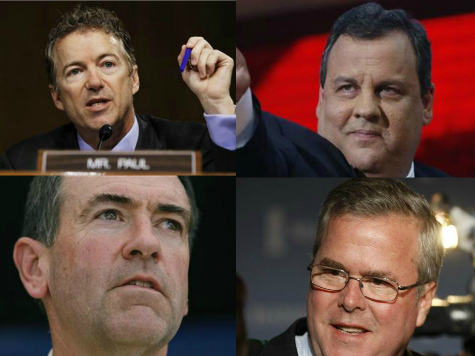
The 2016 GOP presidential field lacks a clear frontrunner, and the gap between the top candidates is the narrowest it has been since 1976, which was the first year in which both parties allowed voters to choose their candidates.
FiveThirtyEight looked at “surveys conducted from January through March of the preceding midterm election year (so for the 2012 election, we’re looking at polls from Jan. 1 through March 31 of 2010),” and found that “the Republican atop the polls has always averaged at least 23 percent of the vote.” This year, former Arkansas Gov. Mike Huckabee leads current polling with 14.8 percent, which essentially ties for the lowest ever on record if its rounded up (Mario Cuomo had 15% at this stage in 1992).
In addition, the analysis found that the difference between Huckabee and Rep. Paul Ryan (R-WI), “who ranks fifth according to polls, is only 4 percentage points. That’s by far the most tightly packed the top five candidates have been in our sample. No other year has a first-to-fifth gap less than 10 points”:
| Mike Huckabee | 14.8 |
| Chris Christie | 13.0 |
| Jeb Bush | 12.2 |
| Rand Paul | 11.1 |
| Paul Ryan | 10.9 |
Though Republicans are more divided, Democrats are more united than ever before, as “Hillary Clinton has 67 percent in the polls, more than the top five Republicans’ average support combined. Clinton is polling stronger than any contender in the modern era on either side, including incumbent presidents George H.W. Bush in 1992 and Jimmy Carter in 1980.” Moreover, the difference between first and fifth contenders is 65 percentage points, which is the “widest gap on record.”
Harry Enten, who did the analysis, notes that polls conducted two years before the election are obviously inconclusive. For instance, Paul may be more of a frontrunner given his potential strength in Iowa and New Hampshire. These polls, do, though, “tell us that the Democratic and Republican fields for 2016 each look very unusual at this point in the race. The Republican picture is unusually muddled, and the Democratic picture is unusually clear.”
Enten also notes that in 2008, Barack Obama was not even in the top five, for instance. Currently missing from the Republican top five are Sen. Ted Cruz (R-TX), who leads among Tea Partiers; outgoing Texas Gov. Rick Perry, who recently came in third in a national survey; former Alaska Gov. Sarah Palin, who has the highest favorability rating among 2016 presidential primary voters and whose endorsement makes the most impact in GOP primaries; Wisconsin Gov. Scott Walker, who may be best able to bridge the gap between the Tea Party and the establishment should he choose to run in 2016; and Sen. Marco Rubio (R-FL), whose organizational strength may be underestimated despite his losing credibility with many conservative voters because of his support for amnesty legislation.
As Breitbart News has been reporting, this uncertainty has led former Florida Gov. Jeb Bush, who may be the establishment’s new top choice, to consider running even though a national Washington Post-ABC News poll found that half of the country would “definitely” not vote for Bush in a general election.
The adage is that Republicans fall in line while Democrats fall in love, but should Hillary Clinton run in 2016, that may be flipped on its head this presidential election cycle as Republicans will be the ones searching for the candidate that best appeals to their hearts among many strong contenders.

COMMENTS
Please let us know if you're having issues with commenting.